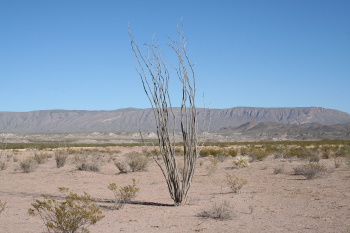Big Bend National Park

Big Bend National Park is part of the Tentative list of United States of America in order to qualify for inclusion in the World Heritage List.
Big Bend National Park lies along the Rio Grande River at the southern border of the United States with Mexico, and contains the largest protected section of the Chihuahuan desert in the United States. The elevation changes in the park allow for ecosystems ranging from dry grasslands and desert landscapes to wetter montane woodlands, which support rare and endangered flora and fauna, including Mexican long-nosed bats and the Chisos agave. Big Bend National Park contains a rich fossil record from the Cretaceous period through the Cenozoic era, and the fossil of the largest known flying creature of all time, the Quetzalcoatlus pterosaur, was identified in the park in 1971.
Map of Big Bend National Park
Load mapThe coordinates shown for all tentative sites were produced as a community effort. They are not official and may change on inscription.
Community Reviews
Ralf Regele

I was initially skeptical if the Big Bend National Park is a good travel choice, let alone a good choice for a world heritage site. It is never mentioned as one of the greatest US national parks, in fact, it is hardly mentioned at all. Also, the often displayed image of an U-shaped canyon is actually from horseshoe bend (1000 miles to the west), and is not present in the Big Bend NP. Luckily, Big Bend turned out to be a very enjoyable national park and worthy candidate. One of its strong points is the presence of three different landscape types within the park: The dry and flat Chihuahuan desert, which is covered with shrubs and all kind of strange plants; then the mountain heights of the Chisos mountains with a more temperate environment, where craggy rock peaks are covered with forests. Finally the river canyon landscape along the south border, where the Rio Grande creates formations similar to the famous colorado river canyonlands. The park is quite big, and it can take up to two hours to drive from the trails at the west to the ones in the east, but the roads and general infrastructure are excellent (as usual in US parks).
Now to the weak points. Firstly, the park is quite remote and out of the way of pretty much anything. It can only be reached by car, and with a long drive. The nearest cities are El Paso to the west (5h drive) or San Antonio to the east (7h). I don't think there is a possibility for a short visit, you need at least half a day to drive in and out, and more than a day to cover all the different landscapes. This remoteness might be a reason why the park is so seldom mentioned - other parks are much more easier to visit. The parks also borders on Mexico, although this doesn't seem to have any negative impact.
Another disadvantage is that the park doesn't have any truly spectacular, unique features. Other parks like Zion, Bryce, Arches offer more iconic sights. Big Bend instead offers a bit of everything, which makes for a great visit but not the greatest photos.
Now to the prospect of becoming a WHS. The official description emphasizes the fossil record, which seemingly covers a large variety of species and a large time window. Now, fossils are always hard to visit or judge. There is a quite nice fossil exhibit in the park, but otherwise, this will not be something the typical visitor will care about. The park also gets points for endemic species, birding, super-clear skies and untouched nature. However, US national parks have a hard time making it on the list, mainly because of a lack of political and popular support. There are already many great national parks on the list of former candidates which didn't made it. In total, do I think that Big Bend NP would be a worthy world heritage site ? Yes ! Do I think that it is the most worthy of the non-WHS US national parks ? Eh, probably not.
Still, I had a great time at the park, and can only recommend the visit to anybody travelling in the region, e.g. between the WHS sites of San Antonio Missions and Carlsbad Caverns.
Visited in October 2023.
Importance 3/5 Beauty 5/5 Uniqueness 4/5 Environment 3/5 Experience 5/5
JLuth
As far as US national parks goes, Big Bend is in our top third favorites. It’s big and has a lot of different things. Tall peaks, water activities, dinosaur fossils and hot springs.
Unfortunately the border into was closed was closed but the crossing and ability to explore another country would be a very cool thing.
Having a 4x4 would really open up this place.
DeanS
Absolutely stunning. If you want off the beaten path, this is it. I visited back in 2013 and absolutely loved it. All of the space and solitude you hope for in the desert environment and more. The hiking is fantastic and even if you visit by car, every few miles yields another new surprise.Community Likes
Site Info
- Full Name
- Big Bend National Park
- Country
- United States of America
- Added
- 2017
- Type
- Natural
- Categories
- Natural landscape - Diverse ecosystems Paleontology - Non-hominid fossils
- Link
- By ID
Site History
2017 Revision
Renomination of former TWHS Big Bend National Park (1990-1996)
2017 Added to Tentative List
Site Links
Visitors
41 Community Members have visited.